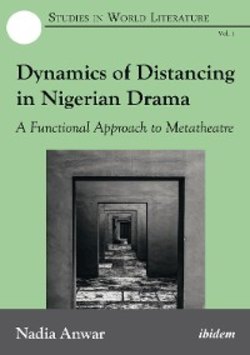Читать книгу Dynamics of Distancing in Nigerian Drama - Nadia Anwar - Страница 3
Table of Contents
ОглавлениеAcknowledgements
Preliminaries
Chapter 1Distancing through Metatheatre
A. Distancing: A Dramatic Imperative
1.1 Bertolt Brecht and Distancing
1.2 Thomas J. Scheff and Optimum Distancing
B. Metatheatre and Dramatic Distancing
1.3 Metatheatre: Conceptual Significance with regard to Distancing
1.4 Metatheatre: A Theoretical History
C. Nigerian Metatheatre: An Under-researched Field
Chapter 2Metatheatre and its Distancing Function in Nigerian Drama
2.1 Metatheatrical Techniques in Nigerian Drama
2.2 Post-Independence Nigerian Playwrights
2.3 Pre-independence Theatre in Nigeria
2.3.1 Egungun Masquerades—A Yoruba Masking Tradition
2.3.2 Mmonwu Masquerades—An Igbo Masking Tradition
Chapter 3Metatheatricality in Wole Soyinka’s Death and the King’s Horseman and King Baabu 3.1 Death and the King’s Horseman
3.1.1 Derivative Narratives as Strategies of Disruption
3.1.2 Metatheatricality at Micro Level
3.1.3 Double Performative Illusions
3.2 King Baabu
3.2.1 Intertextuality as a Source of Metatheatricality
3.2.2 Structural Metatheatricality in King Baabu
Chapter 4Manipulating Distance through Historical Metatheatre: The Case of Ola Rotimi’s Kurunmi and Hopes of the Living Dead
4.1 Reality versus Dramatic Illusion
4.2 Emotions versus Intellect in Rotimi’s Dramaturgy
4.3 Kurunmi—an Historical tragedy
4.3.1 Metatheatricality and Rotimi’s Historical Projections
4.3.2 Metatheatricality through Identification Control
4.3.3 Reporting and Proverbs as Metatheatrical Devices
4.4 Hopes of the Living Dead—A Drama of Struggle
4.4.1 Metatheatricality through the Creation of a Micro-World
4.4.2 Balancing the Ideal and the Common
Chapter 5Femi Osofisan’s Subversive Metatheatre in The Chattering and the Song and Women of Owu
5.1 Explicit Metatheatricality in Osofisan’s Plays
5.2 The Significance of Open-Ended Denouements
5.3 The Chattering and the Song
5.3.1 Theatrical Framing through Play-Within-the-Play
5.3.2 Role-Switching through Iwori Otura
5.3.3 Role-Playing within the Play
5.4 Women of Owu
5.4.1 Textual Frames as Historical Palimpsests
5.4.2 Changing Perceptions through Shifting Foci
Chapter 6Revolutionizing the Metatheatrical Space: Esiaba Irobi’s Hangmen Also Die and Stella ‘Dia Oyedepo’s A Play That Was Never to Be
6.1 Esiaba Irobi’s Radical Postulates
6.2 Hangmen Also Die
6.2.1 Double Framing through Analepsis
6.2.2 Foreshadowing as a Device of Metatheatrical Distraction
6.2.3 Frames of Defiance and Devices of Disruption
6.3 Stella ‘Dia Oyedepo’s Theatrical Reformulations
6.4 A Play That Was Never To Be
6.4.1 The Play-within-the-Theatre
6.4.2 Dramatic Self-Reflexivity
Conclusion
Appendix-I Significant Pre-Independence Performance Traditions in Nigeria
(i) Alarinjo Performances
(ii) Travelling Theatre Movement
(iii) Hubert Ogunde
(iv) Duro Ladipo
Appendix-II
Literary Categories of Meta-Narratives
Appendix-III Interview with Dr Stella ‘Dia Oyedepo (June 2014)
Personal
General
Specific (On A Play That Was Never To Be)
Bibliography
